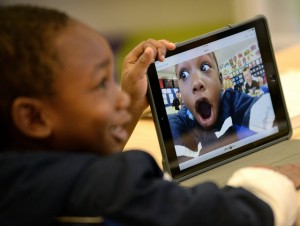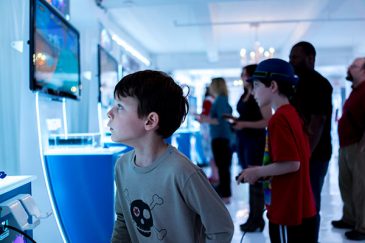Using Apps to Put Creative Tools into Young Hands
July 7, 2015
Family Time with Apps: A Guide to Using Apps with Your Kids is a free interactive guide for parents and caregivers. The book, which is available for free in the iBook store, features comic strips that parents and children can enjoy together, as well as tips on selecting apps that can help turn screen time into family time. We are thrilled to have Stuart Dredge, a journalist and children’s app reviewer, share his thoughts on how the right apps can put some powerful tools in the hands of budding young creative artists.
 I’ve been thinking a lot about “screen time” recently, but not in the usual sense of when to switch off the TV or iPad and send my square-eyed sons out into the garden to kick a football into our ever-patient neighbors’ back garden.
I’ve been thinking a lot about “screen time” recently, but not in the usual sense of when to switch off the TV or iPad and send my square-eyed sons out into the garden to kick a football into our ever-patient neighbors’ back garden.
No, screen time in the sense that most screens are used differently at different times. For my children, the main television screen was very much a passive experience until last year: they sat back on the sofa and watched shows to chill out.

Playing Minecraft on tablets and phones. Flickr / Vy Vu
Then they discovered Skylanders and Minecraft, and woke up to the idea that the TV screen could be interactive. But then they also discovered the world of Minecraft videos on YouTube, which could be beamed onto the television screen via a games console.
They watch and play—either way, creepers and zombies are involved. And the same dynamic applies to the smaller tablet screens in their lives. They understand already that these devices are just as good for lean-back watching as they are lean-forward playing. But they are also great for creating.
There is no parenting manual that can really show you how to make your child creative, other than to make the tools available (crayons, paints, instruments) and hope that at some point, they’ll move beyond redecorating the walls and hitting guitar strings randomly while shouting–although actually, the latter description covers the technique of many of my favorite bands over the years.

Flickr / Zach Frailey
When I talk to other parents, I pick up a concern that tablets and apps aren’t fueling kids’ creativity in the same way that physical materials can–a notion that I politely disagree with. There is a fertile well of apps available for iOS and Android devices that encourage children’s creative instincts.
Some come from the most famous brands, such as Disney’s Mickey’s Magical Arts World–where children create a character that can then be digitally inserted into old Disney clips – and the Story Theater collection of apps that are essentially digital puppet-shows.
Adventure Time Game Wizard turns the popular Cartoon Network show into an all-action game – but the real fun comes from its feature turning children into game designers, creating levels on-screen or even on-paper to play and share.
Other apps come from new names in the children’s apps space. Toca Boca’s playful apps spark all kinds of young synapses, from remixing a song in Toca Band to reshaping coiffures in the Toca Hair Salon apps. The open-ended play of apps like Toca Town also leaves space for children to dream up their own narratives for what they’re seeing on-screen.
This is one of the under-appreciated aspects of this new world. There are many great apps that nudge children with creative tasks, but also many that present them with a set of characters and environments, and leave the plot to them.
Kids are natural storytellers. My sons’ earnest explanation that an alien had swooped down and overhead-kicked their ball over the fence was Oscar-worthy–and some of my favorite apps encourage that skill.
 There are also apps that could spark the next generations of filmmakers and musicians, from video apps like Sesame Street Video Maker, Curious Words and TeleStory to music creation tools like Disco Fingers and Toc and Roll.
There are also apps that could spark the next generations of filmmakers and musicians, from video apps like Sesame Street Video Maker, Curious Words and TeleStory to music creation tools like Disco Fingers and Toc and Roll.
Children with access to a tablet or (parent’s) smartphone in 2015 have access to the kind of tools that only professional filmmakers and musicians could dream of using just a couple of decades ago. My eight-year-old is already tinkering with Apple’s GarageBand and learning to tap things a little less randomly–albeit still with plenty of shouting.
Here in the UK–although also elsewhere in the world–there’s a lot of talk about kids and coding at the moment. In England, computer programming is now on the national curriculum for children as young as five, with a corresponding interest in tools that can make it a friendly experience for them.
Apps have a role here too, from the coding lessons of Tynker to the open-ended creative environment of ScratchJr – via the ‘code your own killer robots’ of Hakitzu Elite.
All these and more play into a wider realization that coding itself is a creative discipline–an art, not just a science. Seeing children telling stories with code, as well as with words and pictures–and increasingly, with all three–is going to be fascinating to watch over the next few years.
With that futurology cap on, think about 3D printing too, and the potential for children to be create things on-screen that can then become physical objects. Apps like Blokify and My Little Monster are early experimenters in that space, but more will follow. Children as toymakers, as well as storytellers. It’s going to be a fascinating few years.
 Stuart Dredge is a UK-based journalist covering consumer tech, digital media and children’s technology. He mainly writes for the Guardian and Observer, as well as music industry publication Music Ally. He is also the co-founder of Apps Playground, a site covering children’s apps for iOS and Android. He is also a father of two and – as many children’s app developers have discovered – the world’s most disorganized emailer.
Stuart Dredge is a UK-based journalist covering consumer tech, digital media and children’s technology. He mainly writes for the Guardian and Observer, as well as music industry publication Music Ally. He is also the co-founder of Apps Playground, a site covering children’s apps for iOS and Android. He is also a father of two and – as many children’s app developers have discovered – the world’s most disorganized emailer.





